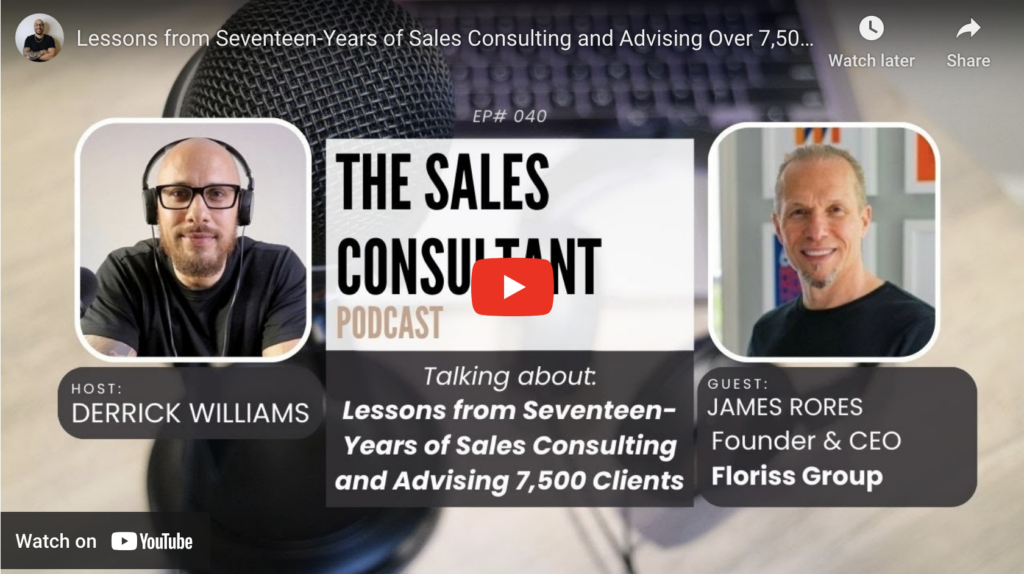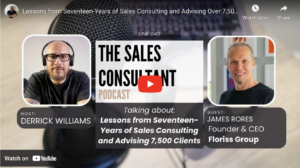Does your company have a Customer Relationship Management (CRM) system? This tool acts as a lifeline to sales. It’s software that houses information about prospects and customers, including data analysis to support your sales cycle stages.
According to industry research, 91% of companies with 11 employees or more have a CRM system. Sounds promising, but unfortunately, 60% of CRM implementations fail. This means 60% of CRM implementations have less than 90% adoption (CSO Insights). However, these statistics don’t clearly define the adoption problem because many companies use manipulative tactics to force employees to use CRM.
For example, the sales manager may tell a salesperson to go out and sell the way they sell, only requiring them to put information into the system when there’s a deal on hand. Is this really adoption? Nope. This is a minimum use of CRM, which won’t allow the tool to deliver its promised impact, because it isn’t being used to guide, document and improve how salespeople sell.
Scary enough, the number of companies that are able to use CRM to optimize how salespeople sell is only 8%.
If you’re someone who is dealing with CRM challenges, you aren’t alone.
Of two-million salespeople studied, 92% do not consistently follow a structured sales process (Objective Management Group). So, how do we effectively deploy CRM without first deploying a sales process people will use? Salespeople need a predictable pattern of success they can count on to optimize how they sell, overachieve goals, and deliver reliable forecasts.
Because nearly every company has a CRM solution, the question for CEOs and Sales Leaders isn’t, should we get a CRM system? The question is, should our CRM system be replaced or redeployed?
It’s easy to blame technology. We all are guilty of doing that at specific points in our workday. But in this case, it’s the lack of a complete sales process that’s at fault. It’s not the technology salespeople don’t want to use, it’s the gaps and misalignment of the sales process creating the real burden.
Salespeople want to sell, sell, sell, and we as managers want that to be their focus. The disconnect is that they don’t see effective selling resulting from using CRM properly. They see CRM as a waste of time, taking them away from actual selling. So, they’re going to use it with minimum effort and resist your attempts at manipulating them or forcing them to use it.
That’s how we know as leaders we must start with foundational questions that will help us define what a complete sales process should be, and what methodology our salespeople should follow to ensure the process is executed at the highest possible level.
When we automate a broken process, we just fail faster. It’s great to scale, but if we’re scaling something that’s broken, we’re going to make that broken element more of a burden which means our salespeople become less efficient and our cost of sales grows even higher.
So, maybe it’s not the technology’s fault. Maybe it’s the actual process we have to look at. Maybe the process we built into the technology isn’t supportive of a high-functioning sales team. And the fact that the sales team isn’t using it is evidence of where our focus should be.
Some leaders run their sales team with the messaging that we don’t care what you do as long as you hit your numbers. That’s one way to manage a sales team. We are comfortable having reps come in and figure it out themselves because we are confident in their abilities. But, in this case, NOT using CRM becomes the reward for sales success, while using CRM becomes the punishment for missing your numbers.
The message being sent is the best salespeople in the organization don’t have to use CRM, because they are more successful without it. Shouldn’t the process and methodology built into your CRM be the one that builds your company’s best salespeople and sales pipelines?
Shouldn’t a reliable sales process be something every member of the sales team can replicate? We need to know the predictable patterns of success that can be replicated across the sales organization and build a structured sales operating model around them.
Once we establish the sales process and methodology, the next step is to test the sales team’s response. Based on their performance, we can make the necessary changes and then repeatedly train everyone to execute in a way that is comfortable for them, as long as they adopt the same patterns of success.
When CRM is a partner in consistently executing a successful sales process, sales teams operate in a more predictable, repeatable way.
The challenge sales leaders face when they have a team of salespeople that move to the beat of their own drum is keeping track of how those individuals sell. From a training standpoint, we can’t help every individual improve because we don’t really understand what those people do to be successful.
There’s nothing scalable when we, as managers, have no knowledge of or influence over the levers that impact our team’s performance. However, when we normalize the team on a single sales operating model, every team member can support the sales manager in optimizing the execution of a shared sales process.
In addition, when everyone is following the same process, the sales manager can distribute knowledge across the team, and the team can provide feedback in a consistent, unified way. Sales is now operating as a team of one.
Using CRM to assist sales improves the sales manager’s ability to add value to each member of the team because the manager can now see where each can improve execution in the context of an accepted best practice. Without a shared process, a sales manager can’t go into the CRM and run the reporting they need to measure performance, produce individual development plans, and optimize every selling day, week, and month of the year.
Not having a unified sales process within the CRM system creates more work and fewer opportunities for the entire sales team.
Creating dashboards and reports that help guide a team and the overall sales strategy minimizes the management burden, allowing a manager to lead more people. In addition, effectively optimizing larger teams creates more scalability and a lower cost of sales for the organization.
Sales is a team sport, and CRM use must expand beyond salespeople who move buyers into and out of an efficient sales pipeline. So, who else should be involved?
- Branding, Marketing & Lead Generation – These team members define ideal customer and buyer personas, go-to-market strategy, buyer-positioning and messaging, channel selection, content creation, lead scoring and conversion.
- Product-Service Marketing – These team members define the problems you solve, establish product market fit, help define ideal customers, buyers and users. They connect your capabilities to specific buyer needs, impacts and desires, support marketing and sales campaigns, deliver competitive insights, and watch market trends.
- Customer Success & Customer Experience – These team members make sure customers feel you have delivered on your brand promise. They ensure customer and revenue retention, referenceability and help drive upsell/cross-sell revenue.
- Sales/Business Development Reps – These team members ensure the connection between marketing and sales by qualifying buyers and buying centers for introduction to your salespeople and entry into the sales pipeline.
- Solution Consultants & Sales Engineers – These team members own the technical aspects of aligning buyer requirements and desired impacts to your recommended solution. They give technical presentations, establish rapport and acceptance with technical and business buyers.
- Sales Operations – These team members own the frictionless enablement of sales team members, including administrative and technical tasks, technology stack deployment, data quality management, reporting, lead management, sales process optimization, knowledge base and content assets, proposal, and contract support.
When we think about expanding CRM use, we want to consider how each sales and customer-facing team can use the system to improve their own performance. But we also want to leverage the system to ensure team alignment around four leading indicators that optimize pipeline flow or velocity.
Number of Qualified Opportunities – How effectively are we filling the pipeline with buyers who have problems we can solve, that must be solved now?
Deal/Lifetime Deal Value – How effective are we at selling value, expanding budgets, minimizing negotiations and discounting?
Win Rate – How effective are we at engaging decision-makers, eliminating competitive threats and securing successful buying decisions?
Sales Cycle Time – How effective are we at becoming the buyer’s emotional favorite, creating buying momentum and shrinking buying cycle times?
Think about how much more your sales engine can be when each sales and customer-facing team is looking for ways to improve these four variables. The real key to CRM success is to have everyone involved in optimizing the sales process. This means the product, marketing, customer success, branding, and sales teams are all on the same page, pulling in the same direction, operating as one. That’s what an effective sales strategy supported by an optimized CRM deployment delivers. And isn’t that what we all want in sales?
Are you confident in your CRM system’s ability to deliver your next level of growth? Continue the conversation with me on LinkedIn and learn more about how we help companies master CRM replacements and redeployments to transform how they sell and deliver a New Growth Curve.
Together,










